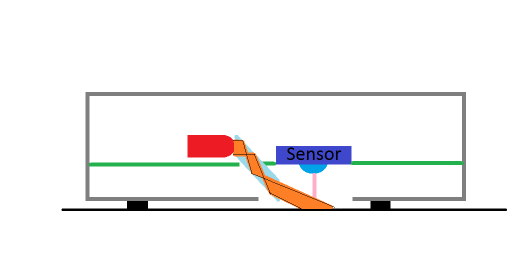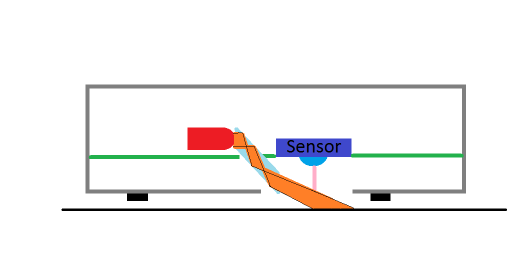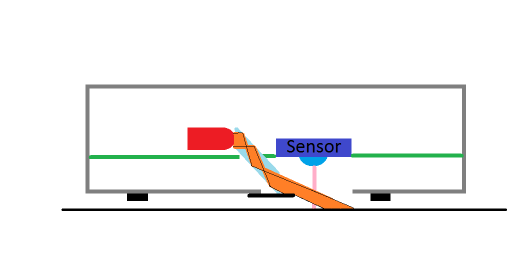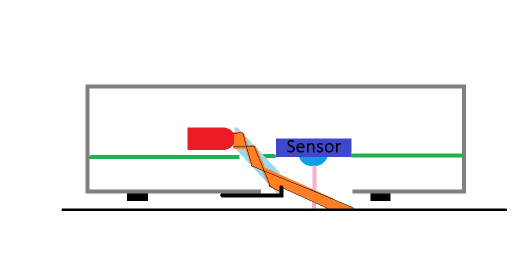After I bought the new CM Storm Spawn mouse and saw that I was unable to adjust to the extremely high liftoff distance (3 CDs on a legacy fUnc 1030), I decided to find ways of reducing the liftoff distance. The most popular method by far is taping a piece of non-clear tape over the light guide that brings light down from the LED. Below I give a (hopefully) simple explanation of why taping works.
We see that the LED gives off light which is passed through the light guide to illuminate the pad surface directly under the sensor. The sensor reading area is a really small area just under the lense, so only a small amount of light would be required.

If the mouse has a poorly designed light guide, the light beam still illuminates the surface right under the sensing area even though the mouse has been lifted.

A properly designed light guide would be one that is inclined more on the horizontal which would cause the light beam to run a lot sooner from under the sensor when lifting off the mouse just a small distance.
To improve liftoff distance for those mice that were not properly designed, some people have found out that taping does seem to have a positive effect. This works because the tape blocks part of the light beam coming from the light guide, which moves the shadow closer to the sensor sensing area. This means that a smaller liftoff distance is required for the shadowed part to move right under the sensor, causing the sensor to be unable to read the surface texture of the pad.
There are two currently known techniques:
1. Taping part of the hole in the mouse base.

2. Taping part of the light guide exit surface.

Both achieve the same thing. While the 2nd variant seems to be the least intrusive and does not risk gathering dust in the sensor area, it's also a lot harder to make the tape stick to the tiny clear plastic surface of the light guide and it is also a lot harder to judge just how much light is going to be blocked off - you want light to illuminate the surface area right under the sensor when the mouse is rested on the pad for it to be able to track your movements. The 1st variant is easier to implement and all you have to do basically is to stick a piece of tape over part of the hole in the mouse base through which light comes out making sure not to cover any part of the sensor lense (the round clear thing which does't emit any light).
If you are doing the taping mod for a mouse with visible light by covering part of the light guide (2nd method) you won't be able to properly judge just how much of the light beam is being thinned by the tape. To help you judge if you did a good job just grab a white sheet of paper and put it over the sensor to partially cover the hole in the base. The light will pass through the paper and you will be able to see if the whole area under the sensor lense would be covered by light.
We see that the LED gives off light which is passed through the light guide to illuminate the pad surface directly under the sensor. The sensor reading area is a really small area just under the lense, so only a small amount of light would be required.

If the mouse has a poorly designed light guide, the light beam still illuminates the surface right under the sensing area even though the mouse has been lifted.

A properly designed light guide would be one that is inclined more on the horizontal which would cause the light beam to run a lot sooner from under the sensor when lifting off the mouse just a small distance.
To improve liftoff distance for those mice that were not properly designed, some people have found out that taping does seem to have a positive effect. This works because the tape blocks part of the light beam coming from the light guide, which moves the shadow closer to the sensor sensing area. This means that a smaller liftoff distance is required for the shadowed part to move right under the sensor, causing the sensor to be unable to read the surface texture of the pad.
There are two currently known techniques:
1. Taping part of the hole in the mouse base.

2. Taping part of the light guide exit surface.

Both achieve the same thing. While the 2nd variant seems to be the least intrusive and does not risk gathering dust in the sensor area, it's also a lot harder to make the tape stick to the tiny clear plastic surface of the light guide and it is also a lot harder to judge just how much light is going to be blocked off - you want light to illuminate the surface area right under the sensor when the mouse is rested on the pad for it to be able to track your movements. The 1st variant is easier to implement and all you have to do basically is to stick a piece of tape over part of the hole in the mouse base through which light comes out making sure not to cover any part of the sensor lense (the round clear thing which does't emit any light).
If you are doing the taping mod for a mouse with visible light by covering part of the light guide (2nd method) you won't be able to properly judge just how much of the light beam is being thinned by the tape. To help you judge if you did a good job just grab a white sheet of paper and put it over the sensor to partially cover the hole in the base. The light will pass through the paper and you will be able to see if the whole area under the sensor lense would be covered by light.
Edited by bkraptor at 06:49 CDT, 23 May 2011 - 45959 Hits

